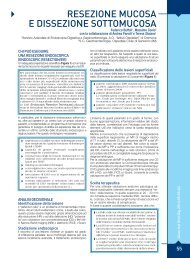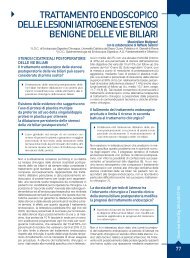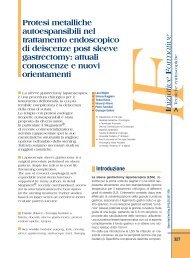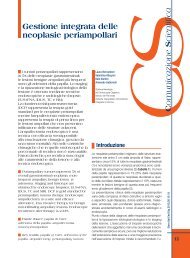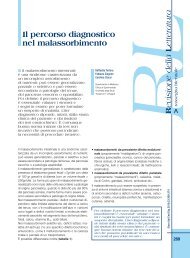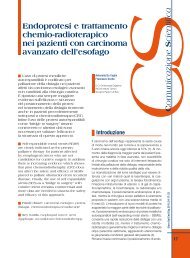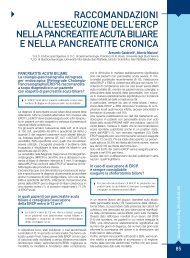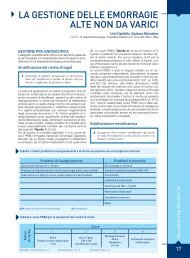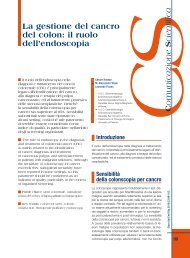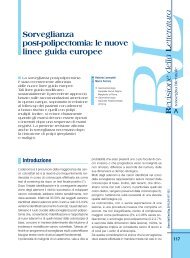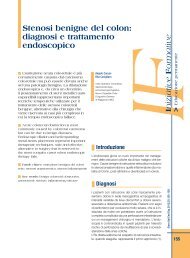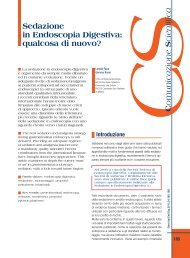le vie biliari nel trapianto di fegato: âil tallone d'achilleâ - Sied
le vie biliari nel trapianto di fegato: âil tallone d'achilleâ - Sied
le vie biliari nel trapianto di fegato: âil tallone d'achilleâ - Sied
- No tags were found...
Create successful ePaper yourself
Turn your PDF publications into a flip-book with our unique Google optimized e-Paper software.
LE VIE BILIARI NEL TRAPIANTODI FEGATO: “IL TALLONE D’ACHILLE”Luca Barresi, Ilaria Tarantino, Gabrie<strong>le</strong> Curcio, Antonino Granata, Roberta Badas, Mario TrainaUnità <strong>di</strong> Gastroenterologia ed Endoscopia Digestiva, ISMETT <strong>di</strong> Pa<strong>le</strong>rmoLe complicanze <strong>biliari</strong> dopo <strong>trapianto</strong> <strong>di</strong> <strong>fegato</strong> sonostate definite il <strong>tallone</strong> d’Achil<strong>le</strong> del <strong>trapianto</strong> <strong>di</strong> <strong>fegato</strong>proprio per in<strong>di</strong>care che esse sono la principa<strong>le</strong> causa<strong>di</strong> morbilità <strong>nel</strong> post-<strong>trapianto</strong>.Esse includono <strong>le</strong> stenosi <strong>biliari</strong>, <strong>le</strong> fisto<strong>le</strong> <strong>biliari</strong>, i calcolie i casts <strong>biliari</strong> e la <strong>di</strong>sfunzione dello sfintere <strong>di</strong> Od<strong>di</strong>.I progressi dell’endoscopia <strong>di</strong>gestiva e della ra<strong>di</strong>ologiainterventistica hanno drammaticamente ridotto lanecessità <strong>di</strong> intervenire chirurgicamente per trattarequeste complicanze.Un approccio multi<strong>di</strong>sciplinare che coinvolge epatologi,endoscopisti, chirurghi e ra<strong>di</strong>ologi interventisti èpertanto necessario in questi pazienti.Biliary complications after liver transplantation havebeen defined as the Achil<strong>le</strong>s’ heel of that surgical<strong>di</strong>scipline, ref<strong>le</strong>cting the fact that they are the <strong>le</strong>a<strong>di</strong>ngcause of postoperative morbi<strong>di</strong>ty. They include biliarystrictures, fistulas, stones, casts, and biliary sphincterof Od<strong>di</strong> dysfunction. Advances in <strong>di</strong>gestive endoscopyand interventional ra<strong>di</strong>ology have significantly reducedthe need for surgery to treat these complications.As a result, a multi<strong>di</strong>sciplinary approach, involvinghepatologists, endoscopists, surgeons, an<strong>di</strong>nterventional ra<strong>di</strong>ologists is required to successfullytreat patients affected with these complications.Paro<strong>le</strong> chiave: <strong>trapianto</strong> <strong>di</strong> <strong>fegato</strong>, complicanze <strong>biliari</strong>,ERCPKey words: liver transplantation, biliary complications,ERCPINTRODUZIONELe complicanze <strong>biliari</strong> (CB) sono il più frequente prob<strong>le</strong>maosservato dopo <strong>trapianto</strong> <strong>di</strong> <strong>fegato</strong> (TF).I dati <strong>di</strong>sponibili mostrano una frequenza variabi<strong>le</strong> tra glistu<strong>di</strong> pubblicati tra il 5% e il 32% (1,2). Nel <strong>trapianto</strong> dadonatore vivente (Living Donor Liver Trasplantation o LDLT)si osserva una maggiore incidenza <strong>di</strong> CB rispetto al <strong>trapianto</strong>da donatore cadavere (Deceased Donor Liver Trasplantationo DDLT) con percentuali, nei lavori pubblicati, chearrivano ad una frequenza <strong>di</strong> oltre il doppio (3,4). Anche idonatori <strong>di</strong> <strong>fegato</strong> possono sviluppare complicanze <strong>biliari</strong>,preva<strong>le</strong>ntemente fisto<strong>le</strong> <strong>biliari</strong>, con percentuali fino al 9% (5).Le CB <strong>nel</strong> post-<strong>trapianto</strong> sono: stenosi <strong>biliari</strong>, fisto<strong>le</strong> <strong>biliari</strong>,casts e calcoli <strong>biliari</strong>, <strong>di</strong>sfunzione dello sfintere <strong>di</strong> Od<strong>di</strong>, mafino al 20% dei pazienti possono avere più complicanzeassociate (Tabella 1).L’imme<strong>di</strong>ata <strong>di</strong>agnosi e trattamento pre<strong>vie</strong>ne <strong>le</strong> complicanzepiù gravi ad essa conseguenti come <strong>le</strong> colangiti, <strong>le</strong> sepsi,l’atrofia lobare, la cirrosi biliare secondaria e la per<strong>di</strong>tadell’organo trapiantato.Il tipo <strong>di</strong> chirurgia usato per la ricostruzione dell’albero biliaredetermina il successivo approccio <strong>di</strong>agnostico-terapeutico.In genera<strong>le</strong>, ma con alcune eccezioni, in caso <strong>di</strong>epatico-<strong>di</strong>giuno anastomosi si preferisce l’approccio biliarepercutaneo transepatico ra<strong>di</strong>ologico (PTC) e <strong>nel</strong> caso<strong>di</strong> co<strong>le</strong>doco-co<strong>le</strong>doco anastomosi si usa l’approccio biliareendoscopico con la colangio-pancreatografia retrogradaendoscopica (ERCP).FATTORI DI RISCHIOCi sono <strong>di</strong>versi fattori <strong>di</strong> rischio per <strong>le</strong> CB dopo TF. In genera<strong>le</strong>possiamo <strong>di</strong>stinguere prob<strong>le</strong>mi tecnici e prob<strong>le</strong>mirelativi all’organo donato (Tabella 2).Tra i prob<strong>le</strong>mi tecnici l’uso del “tubo a T” (T-tube) ha suscitatoun acceso <strong>di</strong>battito tra pro e contro. Una meta-analisi(6) ha <strong>di</strong>mostrato che i pazienti trapiantati senza posizionamento<strong>di</strong> T-tube hanno un outcome migliore rispetto aquelli in cui è stato usato il T-tube, e quin<strong>di</strong> la maggior partedei gruppi ha abbandonato il suo utilizzo.Tabella 1: complicanze <strong>biliari</strong> dopo <strong>trapianto</strong> <strong>di</strong> <strong>fegato</strong>Stenosi <strong>biliari</strong> (~40%-80%)Fisto<strong>le</strong> <strong>biliari</strong> (~2%-25%)Difetti <strong>di</strong> riempimento (~5%)Disfunzione sfintere <strong>di</strong> Od<strong>di</strong> (~2-7%)anastomotiche (~80-90%)non-anastomotiche (~10-20%)anastomotichesede T-tuberesiduo dotto cisticotrancia <strong>di</strong> sezione (LRLTx e Split)calcoli (~70%)casts (~18%)sludge, coaguli, parti <strong>di</strong> protesiEndoscopia post-operatoriabiliopancreaticaGiorn Ital End Dig 2012;35:237-242Complicanze associate (~10-20%)237
Figura 3: complicanze <strong>biliari</strong> associateACBDDISFUNZIONE DELLOSFINTERE DI ODDIPresente dal 2% al 7% dei pazientitrapiantati (2). La causa piùfrequente sarebbe la denervazionedella regione ampollare <strong>nel</strong>dotto nativo. Causa alterazionedegli in<strong>di</strong>ci <strong>di</strong> co<strong>le</strong>stasi, spesso inassenza <strong>di</strong> sintomi. La <strong>di</strong>agnosi sisospetta all’ERCP se si osservauna <strong>di</strong>latazione <strong>di</strong> tutto l’alberobiliare a monte dello sfi ntere <strong>di</strong>Od<strong>di</strong> senza <strong>di</strong>fetti <strong>di</strong> riempimentoo un ritardo <strong>di</strong> svuotamento (> 15min) del contrasto. La <strong>di</strong>agnosimanometrica <strong>vie</strong>ne raramenteeseguita. La risposta alla sfi nterotomiaè del 100%.A) Stenosi anastomotica+calcoli <strong>biliari</strong>B) Dilatazione pneumatica stenosiC) Frammentazione ed estrazione calcoli con cestelloD) Posizionata protesi biliare metallica autoespan<strong>di</strong>bi<strong>le</strong> comp<strong>le</strong>tamente ricopertano indurre ipersaturazione della bi<strong>le</strong> e conseguente formazione<strong>di</strong> calcoli. Il trattamento endoscopico non <strong>di</strong>fferisceda quello riservato normalmente ai calcoli <strong>biliari</strong> (Figura 3A,B,C,D).Un <strong>di</strong>scorso a parte deve essere riservato ai cosiddetticasts <strong>biliari</strong>. Si tratta <strong>di</strong> materia<strong>le</strong>, <strong>di</strong> consistenza variabi<strong>le</strong>da poltacea a dura, che si accumula all’interno del<strong>le</strong> <strong>vie</strong><strong>biliari</strong>, prendendone spesso la forma, composto da materia<strong>le</strong>necrofi brinoso, collagene, aci<strong>di</strong> <strong>biliari</strong>, co<strong>le</strong>sterolo e lacui patogenesi, sebbene non del tutto compresa, è spessoattribuibi<strong>le</strong> ad un danno ischemico del<strong>le</strong> <strong>vie</strong> <strong>biliari</strong>. Il lororiscontro impone dunque un’attenta ricerca <strong>di</strong> cause <strong>di</strong>ischemia come la trombosi dell’arteria epatica. Frequenteè la loro associazione con multip<strong>le</strong> stenosi non-anastomotiche.Quando i casts sono molto estesi <strong>nel</strong>l’albero biliare sipuò confi gurare la cosiddetta “sindrome da casts <strong>biliari</strong>”che è molto <strong>di</strong>ffi ci<strong>le</strong> da trattare endoscopicamente o ra<strong>di</strong>ologicamentee necessita <strong>di</strong> ri<strong>trapianto</strong> <strong>nel</strong> 22% dei casi. Inogni caso il successo <strong>nel</strong> trattamento dei casts negli stu<strong>di</strong>pubblicati non supera il 60% (23) dei casi per <strong>di</strong>ffi coltà <strong>le</strong>gatealla rimozione dei casts, la loro frequente reci<strong>di</strong>va el’ostuzione precoce del<strong>le</strong> protesi.In alcuni casi <strong>di</strong> SNA con casts <strong>biliari</strong> abbiamo utilizzatocon successo protesi in plastica con nuovo <strong>di</strong>segno ad ala(Winged stent or ViaDuct, GI Supply, Camp Hill, PA, USA)(Figura 1 D,E,F) con drenaggio periprotesico, che possonoessere posizionate anche <strong>nel</strong><strong>le</strong> <strong>vie</strong> <strong>biliari</strong> intraepatichesenza il rischio <strong>di</strong> chiudere <strong>le</strong> <strong>vie</strong> <strong>biliari</strong> vicine e che sarebberopiù resistenti all’ostruzione (24). Sono in corso stu<strong>di</strong> <strong>di</strong>valutazione <strong>di</strong> queste protesi.CONCLUSIONILe complicanze <strong>biliari</strong> rimangonoun frequente ed importante prob<strong>le</strong>madopo TF tanto da esseredefi nite il “<strong>tallone</strong> d’Achil<strong>le</strong>” del<strong>trapianto</strong> <strong>di</strong> <strong>fegato</strong>.Una valutazione multi<strong>di</strong>sciplinareè essenzia<strong>le</strong> in questi pazienti.L’ERCP ha <strong>di</strong>mostrato <strong>di</strong> esseresicura ed effi cace <strong>nel</strong> trattamento<strong>di</strong> molte <strong>di</strong> queste complicanzenei pazienti con co<strong>le</strong>dococo<strong>le</strong>docoanastomosi, lasciandola maggior parte dei pazienti conepatico-<strong>di</strong>giuno anastomosi all’approcciora<strong>di</strong>ologico percutaneo.Alcune complicanze <strong>biliari</strong> comequel<strong>le</strong> post-LDLT e <strong>le</strong> stenosi nonanastomotichesono più <strong>di</strong>ffi cili datrattare con l’ERCP che tuttavia non interferisce negativamentesulla eventua<strong>le</strong> successiva PTC e/o chirurgia.Le peculiari caratteristiche <strong>di</strong> queste complicanze <strong>biliari</strong>consigliano che il trattamento <strong>di</strong> questi pazienti sia affi datoad endoscopisti esperti, con un training specifi co sui trapiantati<strong>di</strong> <strong>fegato</strong>.In conclusione, in pazienti trapiantati <strong>di</strong> <strong>fegato</strong> con co<strong>le</strong>doco-co<strong>le</strong>docoanastomosi e complicanze <strong>biliari</strong> la terapia endoscopicaè l’approccio terapeutico inizia<strong>le</strong> più idoneo conuna e<strong>le</strong>vata probabilità <strong>di</strong> successo.TAKE HOME MESSAGELe complicanze <strong>biliari</strong> rappresentano i prob<strong>le</strong>mipiù frequentemente osservati dopo <strong>trapianto</strong> <strong>di</strong><strong>fegato</strong>.Un approccio multi<strong>di</strong>sciplinare che coinvolgachirurgo, epatologo, endoscopista, ra<strong>di</strong>ologointerventista è necessario per trattare efficacementequesti pazienti.Una corretta classificazione del<strong>le</strong> complicanze<strong>biliari</strong> consente <strong>di</strong> pianificare il trattamento miglioree <strong>di</strong> ipotizzarne l’outcome.Nei pazienti trapiantati <strong>di</strong> <strong>fegato</strong> con complicanze<strong>biliari</strong> e co<strong>le</strong>doco-co<strong>le</strong>doco anastomosila terapia endoscopica è l’approccio terapeuticoinizia<strong>le</strong> più idoneo ed associato ad una e<strong>le</strong>vataprobabilità <strong>di</strong> successo.Considerate <strong>le</strong> peculiari caratteristiche <strong>di</strong> questotipo <strong>di</strong> complicanze, gli endoscopisti cheaffrontano queste patologie dovrebbero avereun training specifico <strong>nel</strong> settore dei trapianti.LUNEDì Giorn Ital 2 OTTOBRE End Dig 2012;35:237-242- I SESSIONE241 15
LE VIE BILIARI NEL TRAPIANTO DI FEGATO:“IL TALLONE D’ACHILLE”CorrispondenzaLuca BarresiServizio <strong>di</strong> Gastroenterologiaed Endoscopia Digestiva, ISMETTVia Tricomi, 1 - 90146 Pa<strong>le</strong>rmoCell. + 39 331 1718159Fax + 39 091 2192400e-mail: lbarresi@ismett.eduBibliografia1. Ayoub WS, Esuivel CO, Martin P. Biliary complications followingliver traplantation. Dig Dis Sci 2010;55:1540-1546.2. Krok KL, Cardenas A, Thuluvath PJ. Endoscopic managementof biliary complications after liver transplantation. Clin Liver Dis2010;14:359-371.3. Yazumi S, Yoshimoto T, Hisatsune H et al. Endoscopic treatment ofbiliary complications after right-lobe living-donor liver transplantationwith duct-to-duct biliary anastomosis.J Hepatobiliary Pancreat Surg2006;13:502-510.4. Tarantino I, Barresi L, Petri<strong>di</strong>s I et al. Endoscopic treatment of biliarycomplications after liver trasplantation. World J Gastroenterol2008;14:4185-4189.5. Gruttadauria S, Marsh JW, Vizzini GB et al. Analysis of surgical andperioperative complications in seventy-five right hepatectomies for livingdonor liver transplantation. World J Gastroenterol 2008;14:3159-3164.6. Sotiropoulos GC, Sgurakis G, Radtke A et al. Orthotopic liver transplantation:T-tube or not T-tube? Systemic re<strong>vie</strong>w and meta-analysisof result. Trasplantation 2009;87:1672-1680.7. Sharma S, Gurakar A, Jabbour N. Biliary strictures following livertransplantation:past, present and preventive strategy. Liver Traspl2008;14:759-69.8. Jorgensen JE, Waljee AK, Volk ML et al. Is MRCP equiva<strong>le</strong>nt to ERCPfor <strong>di</strong>agnosing biliary obstruction in orthotopic liver transplant recipients?A meta-analysis. Gastrointest Endosc 2011;73:955-62.9. Chahal P, Baron TH, Paterucha JJ et al. Endoscopic retrograde cholangiographyin post-orthotopic liver transplant population with Rouxen-Ybiliary reconstruction. Liver Trasplant 2007;13:1168-1173.10. Sebagh M, Yilmaz F, Karaman V et al. The histologic patterne of “biliarytract pathology” is accurate fot the <strong>di</strong>agnosis of biliary complications.Am J Surg Pathol 2005;29: 318-323.11. Williams ED, Draganov PV. Endoscopic management of biliarystrictures after liver transplantation. Worl J Gastroenterol2009;15:3725-3733.12. Zoepf T, Maldonado-Lopez EJ, Hilgard P et al. Balloon <strong>di</strong>latationvs. balloon <strong>di</strong>latation plus bi<strong>le</strong> duct endoprostheses for treatment ofanastomotic biliary strictures after liver transplantation. Liver Transpl2006;12:88-94.13. Costamagna G, Pandolfi M, Mutignani M et al. Long-term results ofendoscopic management of postoperative bi<strong>le</strong> duct strictures with increasingnumbers of stents. Gastrointest Endoscopy 2001;54:162-168.14. Pasha FS, Harrison ME, Das A et al. Endoscopic treatment ofanastomotic biliary strictures after deceased donor liver transplantation:outcome after maximal stent therapy. Gastrointest Endoscopy2007;66:44-51.15. Tabibian J, Asham E, Han S et al. Endoscopic treatment of postorthotopicliver transplantation anastomotic biliary strictures with maximalstent therapy. Gastrointest Endoscopy 2010;71:505-12.16. Traina M, Tarantino I, Barresi L et al. Efficacy and safety of fully coveredself-expandab<strong>le</strong> metallic stents in biliary complications after liver trasplantation:a preliminary study. Liver Trasplant 2009;15:1493-1498.17. Garcia-Pajares F, Sanchez-Antolin G, Pelajo SL et al. Covered metalstents for the treatment of biliary complications after orthotopic livertransplantation. Trasplantation Procee<strong>di</strong>ngs 2010;42:2966-2969.18. Tarantino I, Traina M, Mocciaro F et al. Fully covered metallicstents in biliary stenosis after orthotopic liver transplantation.Endoscopy 2012;44:246-250.19. Phillips MS, Monatti H, Sauer BG et al. E<strong>le</strong>vated strictures rate followingthe use of fully covered self-expandab<strong>le</strong> metal biliary stents fo biliary<strong>le</strong>aks following liver transplantation. Endoscopy 2011;43:512-517.20. Haapamäki C, Udd M, Halttunen J et al. Endoscopic treatment ofanastomotic biliary complications after liver transplantation usingremovab<strong>le</strong>, coveredm sel-expandab<strong>le</strong> metallic stents. Scan<strong>di</strong>navian Jof Gastroterol 2012;47:116-121.21. Morelli J, Mulcahy HE, Willner IR al. Endoscopic treatment of post-livertransplantation biliary <strong>le</strong>aks with stent placement across the <strong>le</strong>ak site.Gastrointest Endosc 2001;54:471-475.22. Thuluvath PJ, Atassi T, Lee J. An endoscopic approach to biliarycomplications following orthotopic liver trasplanatation. Liver Int2003;23:156-162.23. Shan JN, Haigh WG, Lee Sp et al. Biliary casts after orthotopic livertransplantation: clinical factors, treatment, biochemical analysis. Am JGastroenterol 2003;98:1861-1867.24. Raju GT, Sud R, Alfert AA et al. Biliary drainage by using stents without acentral lumen: a pilot study. Gastrointest Endoscopy2006;63:317-320.Luca Barresi et al > Le <strong>vie</strong> bilari <strong>nel</strong> <strong>trapianto</strong> <strong>di</strong> <strong>fegato</strong>242 1



